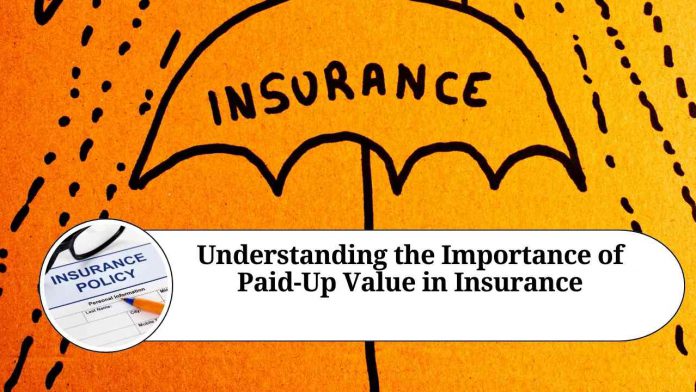Introduction
When it comes to insurance, one term that policyholders should be familiar with is “paid-up value.” Paid-up value is a crucial concept that holds significance for both policyholders and insurance companies. It refers to the value of an insurance policy when the policyholder stops paying premiums and chooses to discontinue the policy. In this blog post, we will delve deeper into the concept of paid-up value and explore its importance in the realm of insurance.
What is Paid-Up Value?
Paid-up value is the sum of money that an insurance policy is worth when the policyholder decides to terminate the policy prematurely. It represents the value the policyholder is entitled to receive from the insurance company after discontinuing premium payments. The paid-up value is calculated based on various factors such as the total premiums paid, the policy’s duration, and the terms and conditions outlined in the policy document.
Understanding the Calculation
The paid-up value is determined using a specific formula provided by the insurance company. The formula considers the policyholder’s premium payment history, the duration for which the premiums were paid, and the surrender value, among other factors. The surrender value is the accumulated amount of money that the policyholder is eligible to receive if they surrender the policy before its maturity date. The paid-up value is usually a percentage of the surrender value and can vary depending on the policy and its terms.
Importance of Paid-Up Value
Financial Flexibility:
The paid-up value provides policyholders with financial flexibility. If a policyholder is unable to continue paying premiums due to financial constraints or changing circumstances, they can choose to discontinue the policy and receive the paid-up value. This can be beneficial as it allows individuals to access a portion of their investment, which can be used for other financial priorities.
Protection against Loss:
Life is unpredictable, and circumstances can change over time. In the event that a policyholder is unable to continue paying premiums and is considering terminating the policy, the paid-up value ensures that they do not lose their entire investment. Instead, they receive a certain amount based on the premiums already paid, providing a safety net and mitigating potential losses.
Investment Appreciation:
Insurance policies often have an investment component that accumulates over time. The paid-up value reflects the value of this investment, considering the premiums paid and the policy’s duration. By discontinuing the policy and receiving the paid-up value, policyholders can still benefit from the appreciation of their investment, albeit in a reduced manner.
Policy Revival Options:
In some cases, policyholders may choose to revive their lapsed policies instead of discontinuing them. The paid-up value can serve as a significant factor in the revival process. Insurance companies may allow policyholders to reinstate their policies by using the paid-up value as a starting point. This option can be advantageous for individuals who wish to continue their coverage after a temporary interruption in premium payments.
Conclusion
Paid-up value is a critical aspect of insurance policies that offers policyholders flexibility, protection against loss, and potential investment appreciation. Understanding this concept empowers policyholders to make informed decisions regarding their insurance coverage and financial well-being. If you find yourself in a situation where you are unable to continue paying premiums, it is essential to consult with your insurance provider to understand the paid-up value and explore the available options. By leveraging the paid-up value, you can make the most of your insurance investment while ensuring financial security.
Read more useful content:
Frequently Asked Questions (FAQs)
Q1: What is paid-up value in insurance?
A1: Paid-up value in insurance refers to the amount of money a policyholder is entitled to receive from an insurance company when they decide to terminate their policy and stop paying premiums. It represents the value of the policy based on the premiums already paid and other factors outlined in the policy document.
Q2: How is the paid-up value calculated?
A2: The paid-up value is calculated using a formula provided by the insurance company. The formula takes into account factors such as the total premiums paid, the policy’s duration, and the surrender value. The surrender value is the accumulated amount of money that the policyholder is eligible to receive if they surrender the policy before its maturity date.
Q3: Can I receive the paid-up value if I stop paying premiums before the policy’s maturity?
A3: Yes, if you decide to discontinue the policy and stop paying premiums before its maturity, you can receive the paid-up value. However, the paid-up value will be a reduced amount compared to the full maturity value, as it is calculated based on the premiums already paid and other factors.
Q4: What happens if I surrender my policy instead of opting for the paid-up value?
A4: If you choose to surrender your policy before its maturity, you will receive the surrender value. The surrender value is the accumulated amount that takes into account the premiums paid and the investment component of the policy. It is usually higher than the paid-up value.
Q5: Can I revive a lapsed policy using the paid-up value?
A5: In some cases, insurance companies allow policyholders to revive their lapsed policies using the paid-up value as a starting point. This means you can reinstate your policy by paying the necessary premiums based on the paid-up value, instead of starting a new policy. The revival option may have specific conditions and time limits, so it’s important to check with your insurance provider.
Q6: Is the paid-up value the same for all types of insurance policies?
A6: The calculation of paid-up value may vary depending on the type of insurance policy. Different policies have different terms and conditions, including how the paid-up value is determined. It’s essential to review your policy document or consult with your insurance provider to understand the specific details for your policy.
Q7: Can I borrow against the paid-up value of my policy?
A7: Some insurance policies allow policyholders to take loans against the paid-up value. This option is often available in policies with a cash value component, such as whole life or universal life insurance. The loan amount is typically a percentage of the paid-up value and is subject to specific terms and conditions set by the insurance company.
Q8: Is the paid-up value taxable?
A8: Generally, the paid-up value is not subject to income tax. However, if the paid-up value exceeds the total premiums paid, the excess amount may be subject to tax as per the tax laws of your jurisdiction. It’s advisable to consult with a tax professional or refer to local tax regulations for accurate information.
Q9: Can I transfer the paid-up value to another insurance policy?
A9: In most cases, the paid-up value is specific to the policy from which it originates. It cannot be directly transferred to another insurance policy. However, you may have options to utilize the paid-up value when purchasing a new policy or making changes to an existing policy. It’s recommended to discuss the available options with your insurance provider.




















